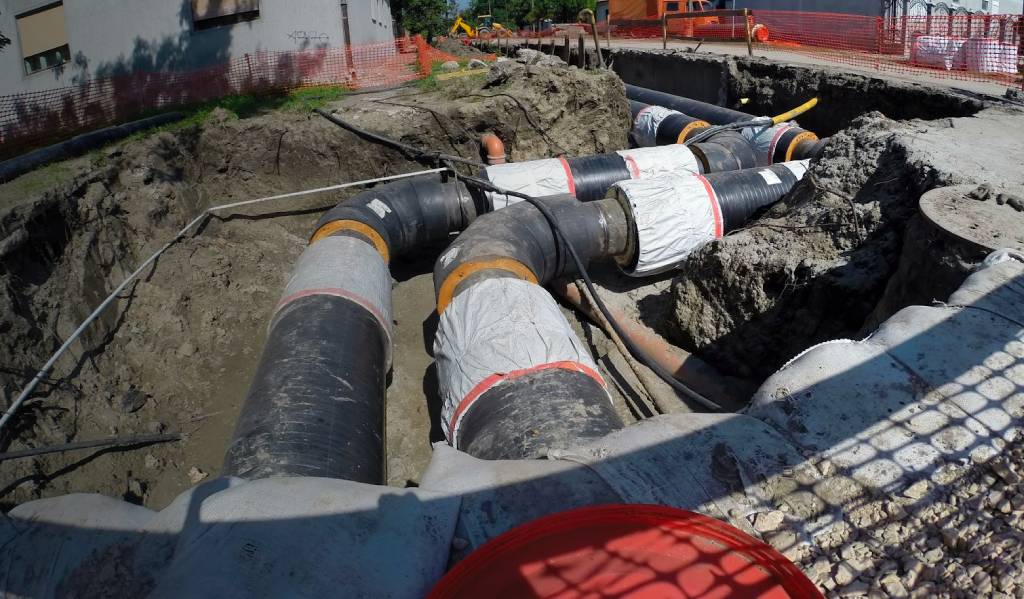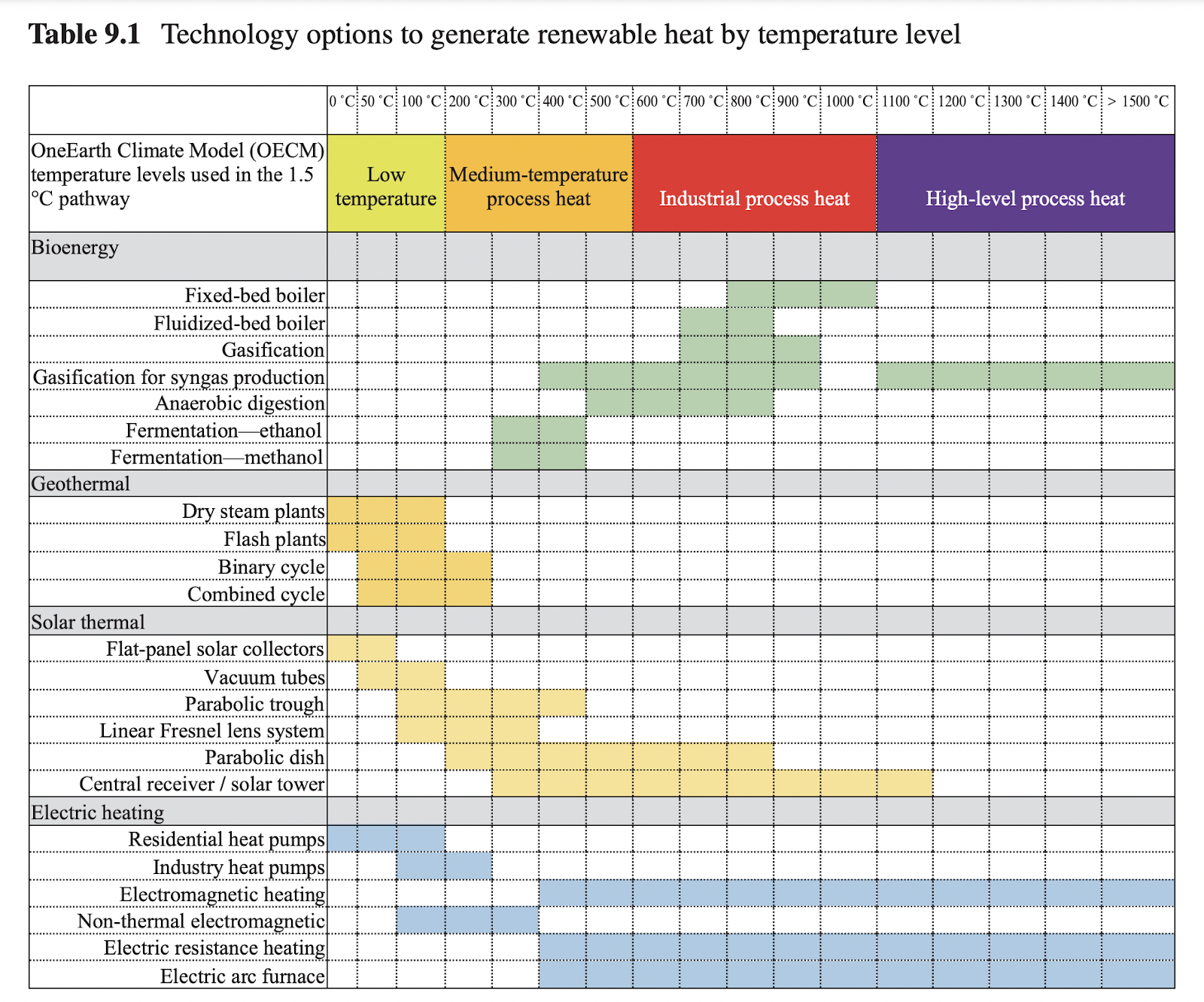Heat is essential to modern life. We use heat to warm our homes, boil our water, create construction materials, process food, and formulate chemicals. This is no small task; heat accounts for half of the global energy consumption, dwarfing the needs for electricity (20%) and transport (30%). Industrial processes that can require temperatures of 1000˚C and above (e.g., making steel or cement) demand around 51% of the energy used for heat. Meanwhile, the lower temperatures we need at home and in our offices rarely exceed 100˚C and make up 46% of our heat energy needs. The small remainder is largely used in agriculture to heat greenhouses. [IEA]
Unlike transport energy which is projected to decrease in demand, global heat demand is expected to modestly increase through 2050 under the One Earth Climate Model (OECM) pathway. Our low-temperature needs for buildings, however, are expected to require less of the pie as efficiency is increased in that sector, while industrial process heat is projected to increase “because energy efficiency measures will not compensate for the increasing production arising from the expected increase in global GDP to 2050.” [APCAG2] In essence, while we are projected to be more efficient across all heat applications in the future, current projections for population and GDP require a large amount of heat-intensive industrial processes.

To make all of this heat using renewable sources will be a defining challenge of the next decades. Currently, 83% of heat is supplied using fossil fuels (primarily gas and coal), and only 9% is from renewable sources (mainly burning biomass). However, the IEA reports that despite renewable heats' currently low percentage, renewable heat consumption has increased year over year by 3.5%. This increase is expected to continue as the OECM pathway projects the phase-out of coal and oil for heat production by 2045 on the way to 100% renewable heat by 2055. This will be achieved by expanding six core technologies:
.jpg)
Photo: Dreamstime
Electric Heat (52%)
As the electric grid transitions to become 100% renewable, electricity will be the largest supplier of emissions-free heat. Heat pumps, induction ovens, and electrical appliances will replace their inefficient fossil fuel counterparts to heat our homes and buildings. For higher heat needs, electric resistance heating, electromagnetic heating, and electric arc furnaces will be used in some industrial applications.

Photo: Dreamstime
Sustainable Biomass (20%)
Combusting biomass in the form of woodchips or agricultural residues, as well as other waste materials, to generate renewable heat without reducing the total extent of forests or croplands. For some applications, biomass can be processed (gasification, pyrolysis, or fermentation) to create combustible gasses or liquids.

Photo: IEA Creative Commons
Direct Solar (15%)
For low-heat needs of residential, commercial, or industrial space heating or water heating, thermal energy can be captured directly from the sun by copper pipes inside a sealed flat plate. For industrial and high-heat applications, solar towers are being developed that use a field of mirrors to concentrate solar on a central tower, achieving temperatures above 1000˚C.
.jpg)
Photo: Dreamstime
Geothermal (10%)
Capturing and distributing the heat within the Earth, which can be accomplished at the district level with larger heat distribution plants or on an individual residential level that uses the steady temperature below the surface as a heat reservoir. This technology is limited to low-temperature needs below 300˚C.
.jpg)
Hydrogen power. Photo: Dreamstime
Green Hydrogen (3%)
Turning hydrogen produced using renewable energy into heat by running it through a fuel cell; is useful for meeting fluctuating demands in heat due to its on-demand nature. Hydrogen gas can be used for all high-heat applications fossil fuels have been used for, making it a critical renewable replacement.

Photo: Dreamstime | new district heat install
District Process (3%)
Utility-scale system for distributing renewable heat generated in a centralized location through a system of insulated pipes for residential and commercial heating requirements such as space heating and water heating.
One of the most exciting and fastest-growing renewable heat technologies, projected to provide 28% of heat energy by 2055, is the heat pump. Heat pumps use renewable energy and refrigerant chemicals to move heat instead of creating heat, making them 2 to 4 times more efficient than gas furnaces. They can transfer heat from a relatively low-temperature source (the outside air or ground) to the inside of a building for space or water heating. They are less efficient at providing higher-temperature heat, don’t work as well in cold climates, and cannot be used for temperatures above 90˚C. However, they can be used for both heating and cooling and cover almost all residential heating needs.


Heat energy is one of the reasons hard-to-abate sectors exist. Achieving high temperatures (above 500˚C) is particularly challenging for renewable energy sources. Each industry sector will use different approaches to decarbonization depending on their heat needs. Certain industries like food, paper, wood, and textiles all operate at heats below 500˚C, so will be easier to decarbonize than the steel, aluminum, and cement industries which need >1000˚C temperatures for over two-thirds of their heat needs.
Nevertheless, these industries can still decarbonize by 2055 by adopting new technologies or changing aspects of their operations. For example, recycling steel requires lower temperatures and up to 74% less energy than creating steel from virgin ore. By projecting the temperature needs of different sectors, it’s possible to plan for and deploy the appropriate technologies at the speed and scale necessary to decarbonize the entire economy.
-
-
Achieving the Paris Climate Agreement Goals, Part 2: https://link.springer.com/book/10.1007/978-3-030-99177-7
-
.jpg?auto=compress%2Cformat)
